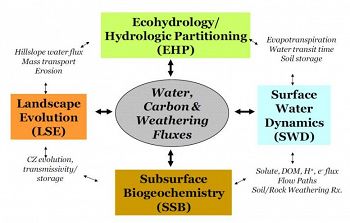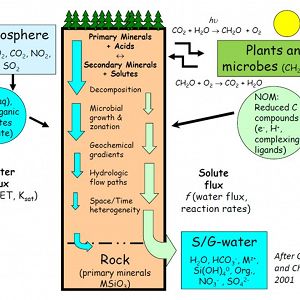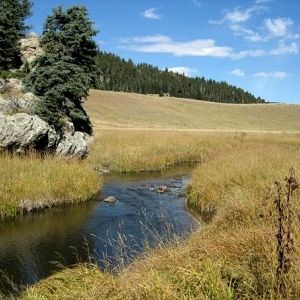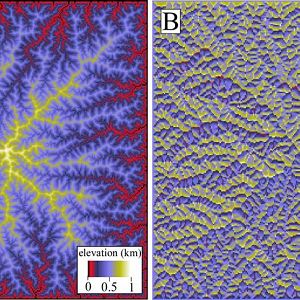Research Foci
The Santa Catalina - Jemez CZO is structured around four cross-cutting science themes linked by critical zone process coupling, energy and mass transfers:
- Ecohydrology and Hydrologic Partitioning
- Subsurface Biogeochemistry
- Surface Water Dynamics
- Landscape Evolution
CZO Integration: Four cross-cutting themes
Ecohydrology and Hydrologic Partitioning
Contact: Paul Brooks, Shirley Papuga (Kurc)
Vegetation, soils, landform morphology, and bedrock play key roles in the partitioning of precipitation into canopy interception, infiltration, storage, soil evaporation, sublimation, plant transpiration, recharge, runoff, and stream flow. Hydrologic flow paths also feed back to affect vegetation structure, microbial community development, soil formation and hydraulic characteristics, landform morphology, mineral surface areas, and carbon transport. This theme is organized to capture these linkages between hydrology and CZ evolution.
Subsurface Biogeochemistry
Contact: Jon Chorover, Craig Rasmussen
Subsurface reactions respond to energy, water, and carbon fluctuations that are superimposed on the spatial variability of solids and fluids distributed along water flow paths. Plants play a key transformative role because they convert water and atmospheric CO2 to photosynthate, translating highly-variable radiant energy into a more persistent subsurface reactant enriched in protons and electrons.
Surface Water Dynamics
Contact: Peter Troch, Thomas Meixner, Jennifer McIntosh
Streams are natural integrators of landscape, subsurface, and in-stream biogeochemical processes at the catchment- to basin-scale. This subtheme utilizes stream water chemistry in relation to hydrologic response to investigate the importance of energy inputs, water transit times, bedrock mineralogy, landscape age, vegetation, and carbon cycling on critical zone development (e.g. mineral weathering rates).
Landscape Evolution
Contact: Jon Pelletier
The landscape is a complex system with many feedbacks and nonlinear relationships between landform structure, soil development, vegetation cover, and water partitioning. Hillslope topography co-evolves with the subsurface weathering front, while erosion, vegetation and weathering affect the storage of C and weathering products in the soil profile, influence soil hydrologic conductivity and affect the partitioning of surface and subsurface runoff, which, in turn, feeds back to vegetation cover and erosion.
Four cross-cutting science themes
To help us to identify and quantify the linkages and feedbacks between physical, chemical, and biological processes in the critical zone (CZ), our research integrates four crosscutting science themes:
- The Ecohydrology and Hydrologic Partitioning (EHP) theme is concerned with the atmosphere-land exchange of water (inclusive of controls over fate of precipitation via evaporation, sublimation, transpiration, runoff and recharge) and carbon (inclusive of net ecosystem exchange of CO2 associated with primary production and ecosystem respiration).
- The Subsurface Biogeochemistry (SSB) theme addresses the impact of water and carbon infusion to the subsurface via soil water infiltration, groundwater recharge, and below ground biomass accretion and turnover. Of particular interest is the distribution in time and space of mineral weathering reactions, some of which are catalyzed biologically, that lead to the formation from weathered rock of structured soil and regolith. Soil/regolith serves as a repository for stabilized carbon and a reservoir for nutrients, and is the structured, porous geomedia that evolves over time to regulate down-gradient flux of water, carbon, and lithogenic or bio-active elements.
- The Landscape Evolution (LSE) theme seeks to resolve the processes and patterns associated with geomorphic change over long (thousands to millions of years) time scales, with a particular focus on rates and mechanisms of soil production and erosion, the formation of hillslope and valley networks, and the impacts of disturbance (e.g., fire) on sediment transport processes.
- The Surface Water Dynamics (SWD) theme is concerned with how the complex spatial-distribution of upland hillslope composition and topography – including the heterogeneous and patchy distribution of vegetation structures, soil and saprolite depths, variably porous bedrock aquifers, and their complex array of hydrologic flow paths - give rise to time-variation in hydrologic (e.g., discharge) and geochemical (e.g., concentration-discharge) responses in effluent surface waters.
These four research foci encompass the inter-related and coupled processes that affect CZ structural evolution over geological time scales and impact its contemporary behavior with respect to the delivery of “CZ services” such as water supply and purification, soil fertility, and ecosystem productivity.
Our CZO personnel include graduate and undergraduate students, CZO staff, and faculty advisors, all of whom are affiliated primarily with one of these science theme areas, but who seek to link their research plans and findings to those of the other themes to enable the development of a transformative and inter-disciplinary science of the Critical Zone.
Explore Further









_76_76_80auto_s_c1.jpg)
